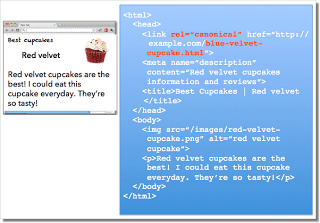
Webmaster Level: Intermediate to Advanced Including a rel=canonical link in your webpage is a strong hint to search engines your about preferred version to index among duplicate pages on the web. It’s supported by several search engines, including Yahoo!, Bing, and Google. The rel=canonical link consolidates indexing properties from the duplicates, like their inbound links, as well as specifies which URL you’d like displayed in search results. However, rel=canonical can be a bit tricky because it’s not very obvious when there’s a misconfiguration. While the webmaster sees the “red velvet” page on the left in their browser, search engines notice on the webmaster’s unintended “blue velvet” rel=canonical on the right. read_more We recommend the following best practices for using rel=canonical : A large portion of the duplicate page’s content should be present on the canonical version. One test is to imagine you don’t understand the language of the content—if you placed the duplicate side-by-side with the canonical, does a very large percentage of the words of the duplicate page appear on the canonical page? If you need to speak the language to understand that the pages are similar; for example, if they’re only topically similar but not extremely close in exact words, the canonical designation might be disregarded by search engines. Double-check that your rel=canonical target exists (it’s not an error or “soft 404”) Verify the rel=canonical target doesn’t contain a noindex robots meta tag Make sure you’d prefer the rel=canonical URL to be displayed in search results (rather than the duplicate URL) Include the rel=canonical link in either theof the page or the HTTP header Specify no more than one rel=canonical for a page. When more than one is specified, all rel=canonicals will be ignored. Mistake 1: rel=canonical to the first page of a paginated series Imagine that you have an article that spans several pages: example.com/article?story=cupcake-news&page=1 example.com/article?story=cupcake-news&page=2 and so on Specifying a rel=canonical from page 2 (or any later page) to page 1 is not correct use of rel=canonical, as these are not duplicate pages. Using rel=canonical in this instance would result in the content on pages 2 and beyond not being indexed at all. Good content (e.g.,...







